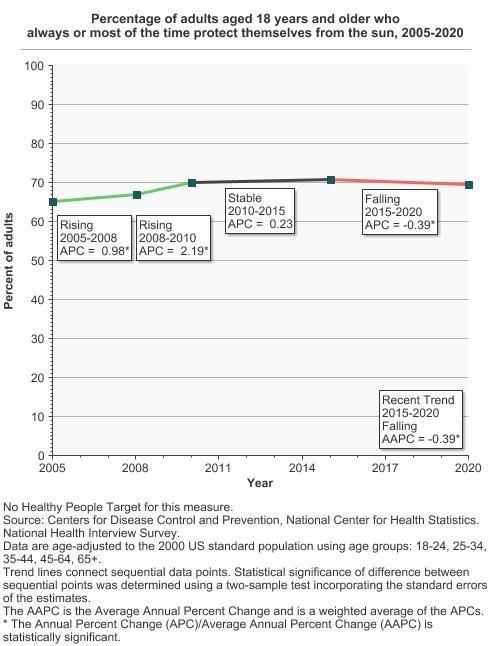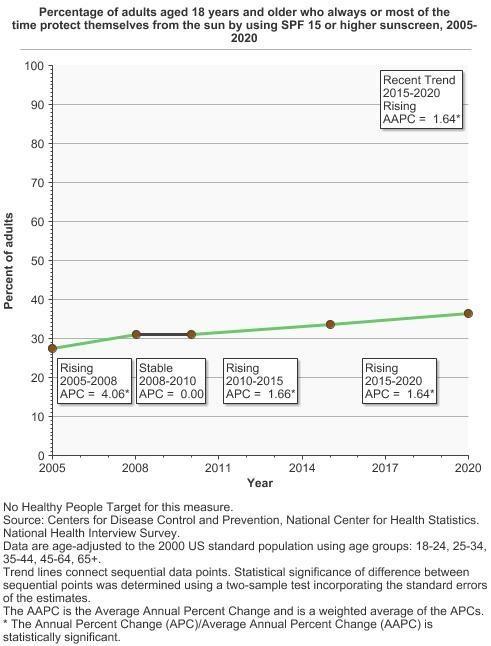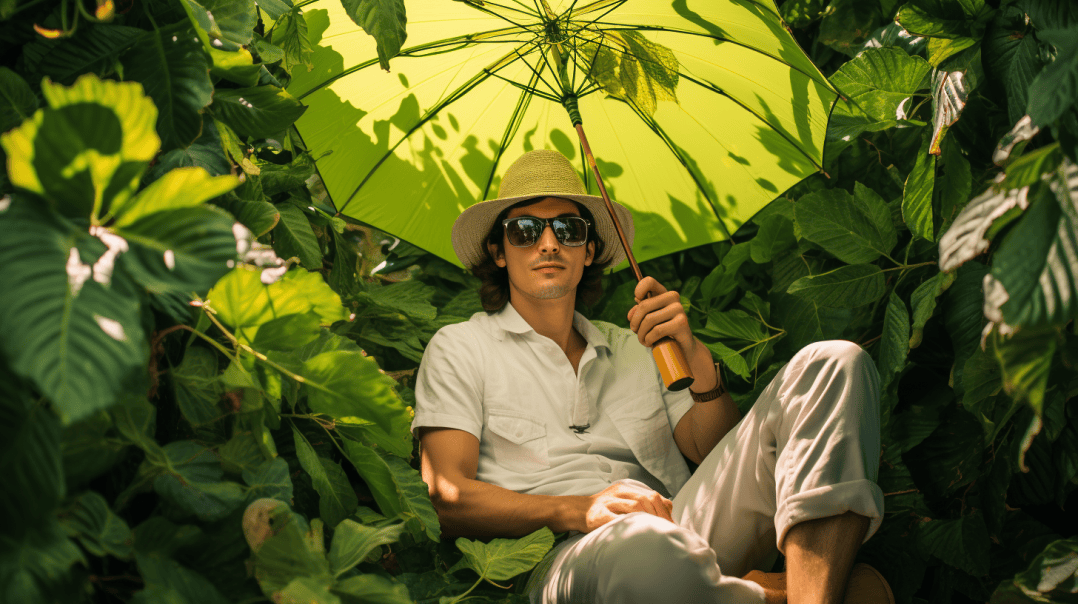Too many men think that sun protection is something that they don't need to worry about. Unlike women who unfairly get judged harshly for having wrinkles, sunspots, and other blemishes on their skin ... for many men it is seen simply as a sign that they have survived hardships and weathered tough times. Unfortunately that isn't going to help you when sun damage causes dangerous damage leading to skin cancer and frankly in today's society ... men are getting judged by how they look almost as much as women are.
So, how about it men. Are you ready to take a look at some ways that you can protect your skin from the sun?
Key Takeaways
- Seek shade under umbrellas, trees, or shelters to reduce sun damage.
- Wear long-sleeved shirts, long pants/shorts, and tightly woven fabric for UV protection.
- Choose a hat with a brim all the way around and wear sunglasses to protect your face, ears, eyes, and neck from UV rays.
- Use broad spectrum sunscreen with SPF 15 or higher, apply it thickly, and reapply every 2 hours or after swimming, sweating, or toweling off.
Why Excessive Sun Exposure Is Bad For Your Body
We all love the warmth and brightness of the sun, but it's important to remember that too much sun exposure can have detrimental effects on your body. Overexposure to the sun's ultraviolet rays can significantly increase your risk of skin cancer. It can also accelerate the aging process of your skin, leading to premature wrinkles and age spots.
Unfortunately far too few adults are following the advice that we thought was common knowledge just a few years ago.

As you can see from this graph by cancer.org, the number of adults using sun protection regularly actually declined compared to trends showing that it was increasing just 15 years ago.
Risks of Skin Cancer
Gentlemen, let's not forget, that skin cancer is the most common cancer in the U.S., and too much sun can be a major contributor! When it comes to sun safety, it's crucial to be aware of the risks:
- The allure of tanning beds is hard to resist for some, but they significantly increase your risk of skin cancer. While this is something more common among women, 1.9 million adult men use tanning beds too.
- There's a strong link between sunburns and skin cancer. Every sunburn increases your risk, so take precautions like wearing protective clothing and staying in the shade when necessary.
- Regular skin checks are essential. Early detection of skin changes can make a huge difference in treatment outcomes.
Remember, your skin's health is worth protecting. Be sun smart and reduce your risk of skin cancer.
Premature Skin Aging
Sure, a golden tan might seem appealing now, but it's not worth speeding up the aging process and dealing with wrinkles, age spots, and loose skin earlier than necessary. That's exactly what too much sun exposure does!
Besides using sunscreen, you can protect your skin by including foods for healthy skin in your diet. Antioxidant-rich foods like berries, spinach, and nuts can help protect your skin from the inside. Natural remedies, like staying hydrated and using aloe vera, can also keep your skin healthy.
remember, shade is your friend! Find comfort under a tree or an umbrella.
The benefits of antioxidants and these simple changes can go a long way in keeping your skin youthful and safe from sun damage.
Eye Damage Potential
Ever considered the potential harm those bright rays could do to your eyes? Sunglasses aren't just a fashion statement, their importance is paramount in protecting your eyes from harmful UV rays. Wearing sunglasses that block both UVA and UVB rays significantly reduces your risk of UV related eye conditions like cataracts.
Remember, not all sunglasses are created equal. The best ones for eye protection are wrap-around sunglasses, as they shield your eyes from every angle. Even the skin around your eyes, often forgotten, gets protection. So, make sunglasses a vital part of your sun safety routine.
Moreover, be aware that UV rays can reflect off surfaces like water and snow, so your sunglasses should be on even on cloudy days. Protect those peepers, they're the only ones you've got!

Sunscreen Is Only One Part Of The Equation
While American adults today may be less focused on sun protection overall, sun screen remains a popular solution to protecting one's skin. However, it is far from the only solution and it can be a bit complicated sometimes when you look at different types of creams to protect your skin from the sun's rays.
Understanding Sunscreen
Sunscreen is a crucial part of any skin care routine, especially for those who spend a lot of time outdoors. It works by either absorbing or reflecting the sun's UV rays, preventing them from penetrating the skin and causing damage. There are two types of UV rays: UVA, which can prematurely age your skin, causing wrinkles and age spots, and UVB, which can burn your skin. Too much exposure to either can lead to skin cancer. Therefore, it's important to use a broad-spectrum sunscreen, which protects against both UVA and UVB rays.
SPF and Application
The effectiveness of sunscreen is measured by its Sun Protection Factor (SPF). The SPF number indicates how well the sunscreen protects against UVB rays. For example, if you use an SPF 30 product properly, it would take you 30 times longer to burn than if you used no sunscreen. However, no sunscreen can block 100% of UV rays. SPF 30 sunscreens block about 97% of UVB rays, while SPF 50 sunscreens block about 98%. It's recommended to use a sunscreen with an SPF of at least 30.
Proper application is also crucial for effectiveness. Sunscreen should be applied generously and evenly to all exposed skin and should be reapplied at least every two hours, or immediately after swimming or sweating.
Reef Safe Sunscreen
Reef safe sunscreen is a type of sunscreen that is believed to be less harmful to coral reefs. Some sunscreens contain chemicals like oxybenzone and octinoxate, which have been found to contribute to coral bleaching. When choosing a sunscreen, look for ones labeled as "reef safe" or "reef friendly". However, it's important to note that the term "reef safe" is not regulated, so it's still important to check the ingredients.
Sunscreen vs. Suntan Lotion
Sunscreen and suntan lotion are not the same and serve different purposes. Sunscreen is designed to protect your skin from the sun's harmful UV rays. On the other hand, suntan lotion is designed to help you tan. It usually contains oils that attract and focus UV rays onto the skin. While suntan lotions may contain some SPF, they do not offer the same level of protection as sunscreen and can increase your risk of sunburn and long-term skin damage.
Remember, while sunscreen can significantly reduce your risk of sun damage and skin cancer, it's not a complete shield. It's still important to seek shade during the peak sun hours of 10 a.m. to 4 p.m., and to wear protective clothing, like a wide-brimmed hat and sunglasses, when possible.
Factors That Can Affect Harmful UV Exposure
Did you know that several factors can significantly impact your exposure to harmful UV rays, and it's not just about how long you're in the sun?
For instance, you're actually exposed to more UV rays if you're closer to the equator or at a higher elevation - in fact, UV exposure increases by nearly 4% for each 1,000-foot increase in altitude.
Consider these factors in your daily life:
- The time of day: UV rays are strongest between 10 a.m. and 4 p.m.
- Where you live: The closer to the equator, the stronger the UV rays.
- Outdoor activities: Choose shaded areas for your activities and check the UV index.
- Food choices: Some foods may boost your body's natural sun protection.
Remember, your skin health matters, and you're part of a community that values sun safety.
Behavior Changes To Limit Sun Exposure
Making simple changes in your daily habits can greatly reduce your exposure to harmful UV rays. Start by modifying your outdoor activities; aim for early morning or late afternoon, avoiding the sun's peak intensity hours between 10 a.m. and 4 p.m.
Cultivate sun protection habits like seeking shade under trees, umbrellas, or other shelters, particularly when the sun is strongest.
Remember, sun safety isn't seasonal, it's a year-round commitment. Even on cloudy days, UV rays can reach you, so keep your protective clothing, hat, and sunglasses handy. In fact, just like when you are out on the water, the sun's rays can reflect in dangerous ways off of snow as well so be safe and protect yourself from the sun even when skiing and other winter activities.
Embrace behavior changes that prioritize your skin health. By doing so, you're not just protecting yourself but also setting an example for those around you, fostering a sense of shared responsibility in sun safety.
Clothing To Help Protect Your Skin From Harmful Rays
Donning the right attire can be a game changer, shielding your delicate skin from those devious UV rays. By being mindful of your clothing choices, you can enjoy the benefits of shade even when you're out in the open. Here's what you need to remember:
- Opt for long-sleeved shirts and pants that are tightly woven. They provide a solid barrier between your skin and harmful rays.
- Darker colors aren't just stylish, they offer more UV protection than lighter hues.
- Look for stylish sun protective clothing that's certified for UV protection.
- Never underestimate the importance of hats in sun protection. Choose a full-brimmed one for maximum coverage.
- Long sleeves may be impractical but you can seek shorts that are longer that normal. For instance 22 inch boardshorts instead of ones that come above the knee.
Foods And Nutrients That Can Help Protect From Sun Damage
Nourishing your body with the right foods can surprisingly offer an extra layer of defense against harmful UV rays.
foods and nutrients that can help men protect their skin from sun damage and aid in recovery after exposure to harmful UV rays.
- Vitamin C: This antioxidant helps to neutralize the free radicals generated by sun exposure, reducing inflammation and helping to prevent damage. Foods rich in Vitamin C include citrus fruits like oranges and grapefruits, strawberries, bell peppers, and broccoli.
- Vitamin E: Vitamin E is another antioxidant that can help protect the skin from UV damage. It's found in foods like almonds, spinach, sweet potatoes, avocados, and sunflower seeds.
- Beta-Carotene: This is a type of carotenoid that gets converted into vitamin A in the body, which is essential for skin health. Foods high in beta-carotene include carrots, sweet potatoes, spinach, and kale.
- Omega-3 Fatty Acids: These fatty acids help maintain the health of the skin's cell membrane, which acts as a barrier to harmful substances and also aids in retaining moisture. Foods rich in omega-3s include fatty fish like salmon, mackerel, and sardines, flaxseeds, and walnuts.
- Lycopene: This is a powerful antioxidant that can help protect the skin from sun damage. It's most commonly found in tomatoes and other red or pink fruits like watermelon, pink grapefruit, and guava.
- Green Tea: Green tea contains polyphenols, which can act as a natural sunblock and protect against skin cancer by neutralizing harmful free radicals.
- Dark Chocolate: Dark chocolate is high in flavonoids, potent antioxidants that can help protect the skin against sunburn, while also improving skin hydration and complexion.
- Water: While not a food, staying hydrated is essential for skin health. Water helps to hydrate the skin and maintain its elasticity, making it more resilient to sun damage.
Remember, while these foods can help protect your skin and aid in recovery, they are not a substitute for sun protection measures like using a broad-spectrum sunscreen, wearing protective clothing, and avoiding the sun during peak hours.

